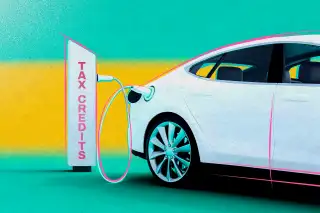New EV Tax Credits Could Save You $7,500 on Your Next Car

New year, new EV? Expanded tax credits for electric vehicles and plug-in hybrids that went into effect at the start of 2023 could save you thousands of dollars.
In August, President Joe Biden signed into law the Inflation Reduction Act, a major climate and tax spending package. A key provision in the sprawling legislation aims to make electric vehicles more affordable by revamping how EV tax credits work.
A big expansion to the tax credit is in effect as of Jan. 1, 2023. In short, the law provides tax credits of up to $7,500 for certain new electric cars and up to $4,000 for used EVs. Income caps for buyers also apply: $150,000 a year for singles (or $300,000 for couples) purchasing new EVs and $75,000 for singles (or $150,000 for couples) purchasing used EVs.
However, complex restrictions on what vehicles may qualify for the tax credit — as well as how the tax credits are applied in their first year — can complicate the buying process.
Eligibility for 2023 EV tax credits
Electric vehicles aren’t exactly known for their affordability. According to the latest data from Kelley Blue Book, the average price of a new car is about $49,000. For EVs? It's $65,000.
The new tax credits could help bring down that price by as much as $7,500, but the credits don’t apply to every EV or plug-in hybrid on the market. There are several eligibility requirements you should know about before heading to the dealer.
What EVs qualify for expanded tax credits?
The expanded $7,500 tax credit applies only to new electric or plug-in hybrid vehicles that were assembled or manufactured in the U.S. This stipulation alone cuts out many popular EV models, like Hyundai’s Ioniq, Kona Electric and Nexo. (Additional requirements on critical mineral and battery components are forthcoming from the Department of the Treasury in March 2023.)
In the meantime, the U.S. Department of Energy has released a list of more than 40 models that may be eligible for the newly expanded EV tax credit.
Examples include:
- 2022 and 2023 Nissan Leaf
- 2022 and 2023 Tesla Models 3, S, X and Y
- 2022 Audi Q5
- 2022 and 2023 Chevy Bolt EV
Not all models included on the Energy Department’s list are guaranteed to be eligible for the credit. Sometimes manufacturers produce the same model at different plants. To double check exactly where the EV was assembled, find the VIN number of the EV and plug it into the Department of Transportation's VIN decoder for more information about a particular vehicle’s plant of manufacture.
In addition to the $150,000 income limit for new EV buyers, limits on the sales price of new vehicles also apply. The IRS says that price tags on new electric vans, SUVs or trucks can’t exceed $80,000 — while all other types of vehicles must have an MSRP of $55,000 or less.
For used EVs, the requirements are laxer:
- The buyer must meet the income threshold ($75,000 for singles; $150,000 for couples).
- The EV must be at least two years old from the year of purchase.
- The used EV price can’t exceed $25,000.
- The tax credit is equal to 30% of the purchase price up to a maximum of $4,000 (whichever is lesser).
When should you buy an electric car?
Some experts say that if you’re already in the market for a new electric vehicle, early 2023 could be a good time to buy.
For instance, the industry publication Electrek noted that because the Treasury Department has delayed its guidance around battery components, you may have a window of time between January and March 2023 to score the full $7,500 tax credit on EVs that are assembled in the U.S. but probably won’t meet the to-be-determined battery specifications. (One of the cheapest electric cars on the market, the $25,000 Chevy Bolt EV, is an example in which the savings seems particularly substantial.)
In other words, battery requirements will get stricter in the coming months and years, and that could knock some EVs off the list of cars that qualify for the full $7,500 tax credit.
However, if you’re interested in a used EV and are in no rush, it may make sense to wait. Because there are fewer restrictions on the makes and models eligible for the used EV credit, there’s less pressure to buy.
Likewise, for purchases made in 2023, the EV tax credit will be reimbursable when you file your taxes the following year. In other words, you won’t see the money for some time.
In 2024, however, the tax credit becomes available at the point of sale — and will be more akin to a discount applied on the EV at the time of purchase.
More from Money:
Holiday Sales Events on New Cars Are Everywhere. But Are There Actually Good Deals?